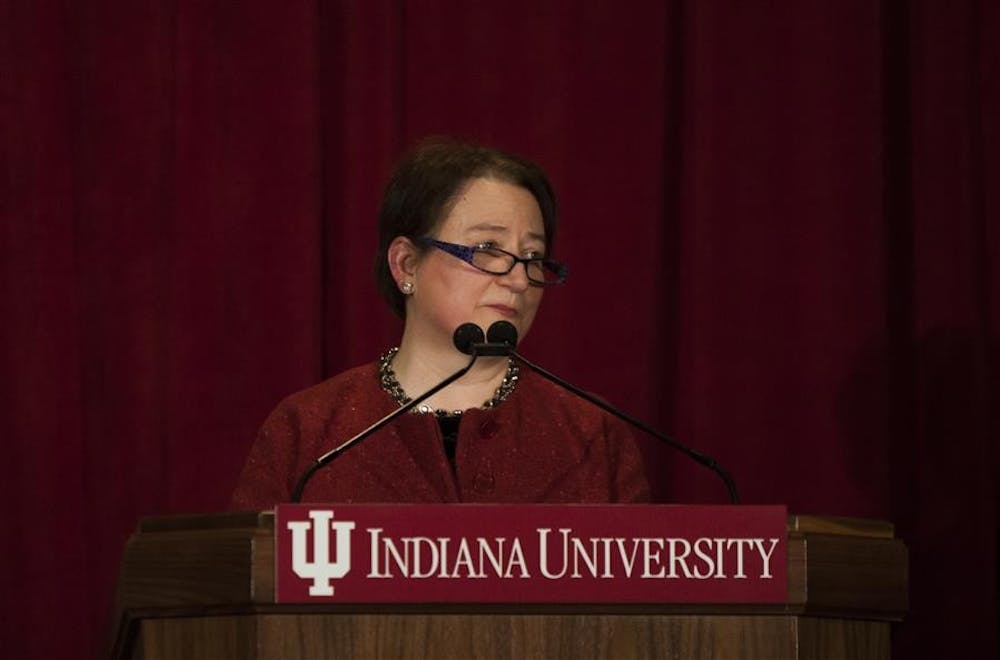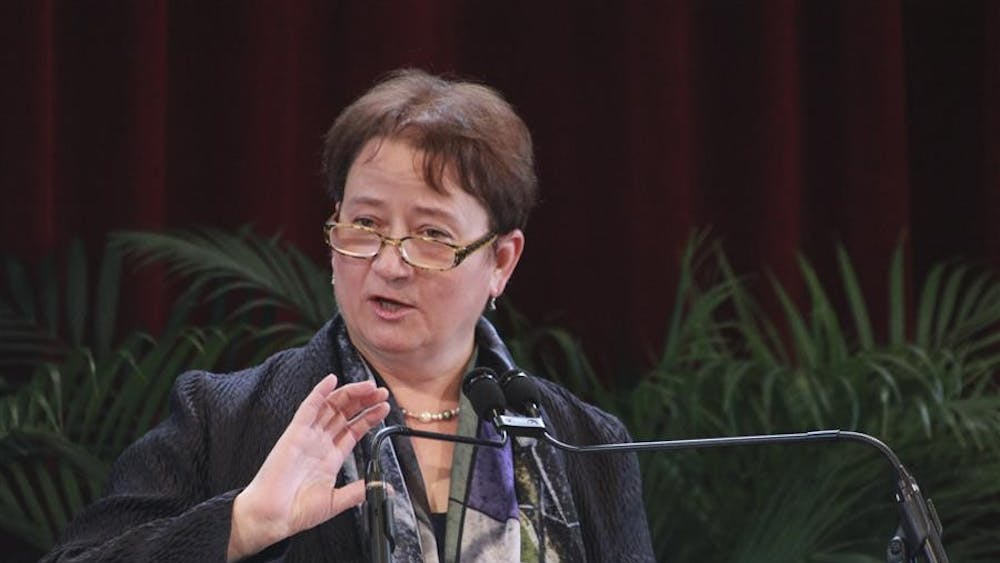Students, faculty and staff might want to pay attention to the draft of IU’s new Strategic Plan. Big changes are on the way, and Provost Lauren Robel is inviting public feedback.
The product of a semester’s worth of work on the part of 11 committees, the IU-Bloomington Campus Strategic Plan outlines a plan to expand IU’s global presence, update financial aid and realigns interdisciplinary education. And those are only a few aspects of the six broad initiatives Robel’s attempting to address.
Before the Strategic Plan is finalized, however, Robel wants public feedback on the draft released Wednesday. The draft’s release came two weeks in advance of a town hall meeting for public comment, and with an online response form.
Meanwhile, it’s time for members of the IU community who want their voice heard to familiarize themselves with the 21-page draft that might affect almost every experience at the University for the next five years.
THE FOUNDATION
The Strategic Plan built on what the plan calls “five successful and ambitious initiatives that challenged us to recreate Indiana’s pre-eminent university for the 21st Century.”
These five documents are “New Academic Directions,” “New Directions in Teaching and Learning,” “Indiana University International Strategic Plan,” “Report on the Old Crescent” and “Empowering People: Indiana University’s Strategic Plan for Technology.”
All five plans have been released in the past six years. These initiatives target specific areas in IU’s broad reach and served as a jumping-off point for the Strategic Plan.
“Sometimes people talk about a strategic plan and they say, ‘If you were to start from scratch, what would you do?’ Well, we’re not starting from scratch,” Robel said during the Bloomington Professional Meeting Wednesday.
“We’re starting from almost two full centuries of history,” she said.
The 21-page plan is broken down into six main points: undergraduate life, graduate education, research, faculty development, globalization and internationalization and collaborative program initiatives.
GRAND CHALLENGES
Undergraduate life is by far the largest portion of the plan, and it covers everything from financial needs to the arts to expanding opportunities for international students.
The plan explicitly mentions the establishment of Hutton HonorsCollege as a “central hub” for interdisciplinary education; the introduction of a new Center for Excellence in STIM; and the creation of professional master degrees in certificates in every school in the college.
Neither Robel nor officials elaborated, and much of the remaining language is even more vague.
The draft announces a new focus on growing the number of underrepresented minorities at IU, without mentioning a specific solution.
Hints at continued growth for online courses, recruitment efforts abroad and more efficient career advising also appeared in plans for undergraduate development.
Standing in the way of those plans, though, are what Robel calls “grand challenges.”
“We have a clear need to be able to knock down barriers to interdisciplinary work and to approach what many of the teams call ‘grand challenges,’” Robel said. “Big wicked problems that are important for the world to better, for academic institutions to take on, grapple and try to solve.”
“Grand challenges” is a phrase that often comes up throughout the document and is meant to encompass the significant problems that face each individual area of the plan.
“IUB already provides an amazingly rich and engaging undergraduate experience. The grand challenge, then, is how do you take something great and make it even greater?” said Dennis Groth, co-chair of the undergraduate life committee.
A large part of the undergraduate life section laid out a plan for the different schools within IU to work together, as well as to work globally with other institutions.
“Interdisciplinary approaches and globalization are key elements for the plan, and for good reason,” Groth said. “Clearly, the benefits of bringing together diverse skill sets, knowledge frameworks, and perspectives always yields the best solutions to the wicked problems we expect out students to be prepared to solve. What we do, what we create, what we collaborate on, all have global contexts and impacts.”
POST-GRAD ON FAST TRACK
The graduate education section of the plan most notably includes expanding financial aid for students in the graduate program and to reducing the time to complete a Ph.D.
“I think that we all feel very strongly that it’s frankly a moral issue to assure that our students don’t wander off path or fail to be able to complete their graduate degrees, because they can’t get the funding to do it or they can’t get the support or the guidance,” Robel said.
The plan also outlined proposals to recruit more international students and create online graduate programs for every school.
TARGETED RESEARCH
The plan envisions IU to advance its reputation for world-class research.
The draft proposes that every year for the next five years, deans and faculty will be required to identify emerging areas of importance for research.
According to the plan, IU needs to position itself as a preferred collaborator and develop “strategic partnerships” in and outside the government.
“One of the things that we have to be able to do in the sciences is really be strategic about where are sciences so expensive, where can we be the best, because that’s where funding will actually go,” Robel said. “One concept that runs through this report is the concept of being a preferred collaborator. What does it take to be a collaborator of choice in the sciences in the global realm?”
Robel said it’s a two-part answer: the ability for IU to be really good at something, and that IU can’t have policies that deter partnerships.
“It’s a little phrase, but there’s a lot that sits underneath it,” Robel said.
CHANGING TENURE
According to the plan, decisions about family leave will not negatively affect tenure. It’s a move Robel said is part of efforts to make IU more family friendly.
It outlined the possibility for child-care opportunities and expanding opportunities for faculty to work elsewhere while teaching.
That’s not all for faculty.
Their section is the second-largest of the plan, and outlines an initiative to bring in more diverse faculty that is valuable throughout the University.
Retaining faculty is another mission for the plan. Faculty might be able to teach in different schools.
IU’S GLOBAL REACH
The international initiatives section outlined IU’s goal to become a more globalized campus, most notably through gateway centers in other countries.
Gateway centers are IU offices located outside of the U.S. that provide a hub for students to have a home away from home for experiential learning, conducting research and field study, said M.A. Venkataramanan, vice provost and chair of the international initiatives for programs and facilities committee.
IU already has a gateway center in India, and another is set to open in China by June 2014.
Robel said she expects three or four more centers to open in the next couple of years.
RENEWED PROGRAMS
The final section of the plan outlined an initiative to renew programs and outreach.
It outlined a plan to expand IU’s arts and humanities programs across campus, making it so every student will have the opportunity to see a theater production or attend an art exhibit during their time at IU.
“A goal of that is to really bring together the impact of all of the cultural institutions that we have in Bloomington that are just phenomenal,” Robel said.
IU wants to ensure that when students leave this place, Robel said, they leave as passionate advocates for the arts and humanities.
“We have the enormous privilege of having students with us from all over the world, but also from all over our state and all over our country,” Robel said. “And many students come from places where they’ve never had the opportunity to engage in the arts and humanities the way they can on this campus.”
A downloadable PDF of the Campus Strategic Plan draft can be found online at plan.indiana.edu.
Follow reporter Kathrine Schulze on Twitter @KathrineSchulze.
Provost invites input on Strategic Plan

Get stories like this in your inbox
Subscribe





